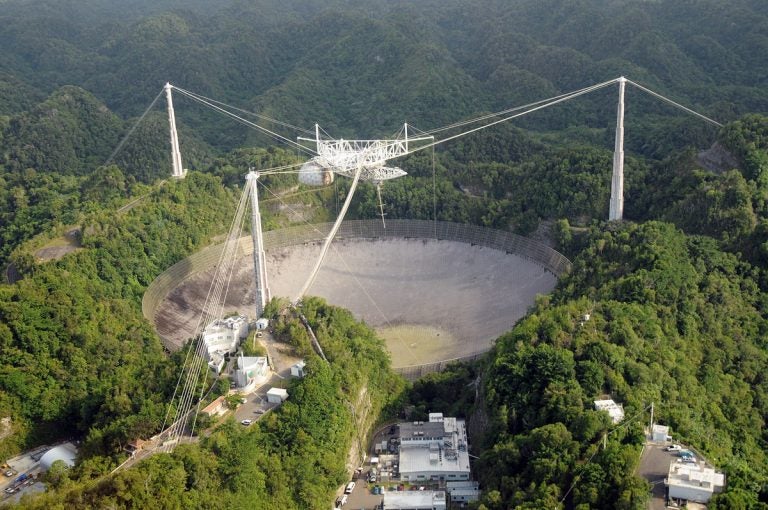When the University of Central Florida took the helm of the Arecibo Observatory in Puerto Rico on April 1, the university entered a new era.
“We are forging new ground for UCF,” said Elizabeth Klonoff, vice president for research and dean of the College of Graduate Studies. “We already have outstanding research in planetary sciences, especially in the area of asteroids. Arecibo is an opportunity to expand our space science research and puts us on track to become a national leader in space science research.”
Faculty in the College of Sciences and at the Florida Space Institute in Central Florida Research Park already work on NASA missions and with commercial space companies on a variety of projects that involve asteroids, the moon and Mars. Many of those faculty are already working on plans to conduct more in-depth or completely new space research, now that the observatory is available.
“UCF is now an important player in how astronomy moves forward in the U.S.,” said physics Associate Professor Yan Fernandez. He is a co-principal investigator on the Arecibo project.
There are only two telescopes with radar capacity in the world and Arecibo is one of them. To have this type of technology at a researcher’s fingertips, is going to make UCF an even more attractive institution for space studies, Fernandez said.
Built in the 1960s, the observatory continues to make significant contributions to understanding the universe. Scientists from around the world have used it to do everything from monitoring binary pulsars to verifying the existence of gravitational waves. Several scientists at the facility, who are now part of UCF, focus their research on radio astronomy, atmospheric science and planetary science.
That’s where Fernandez comes in. He specializes in comets and asteroids and is excited about what the future holds.
“Being able to bounce radar echoes off of asteroids is a really exciting thing to do,” he said. “I want to look at some new objects and new comets. There are few places to find this type of data, so to have access to the Arecibo facility is amazing.”
Scientist Noemi Pinilla-Alonso, another co-principal investigator on the Arecibo project, is excited about having access to the observatory because it provides another tool to continue her 20 years of research into primitive asteroids. This type of asteroid may hold clues about the origins of water and life on planet earth.
Pinilla-Alonso hopes to join the team of scientists at Arecibo to study near-Earth asteroids, or NEAs. There are hundreds of NEAs and some could pose a danger to Earth. By knowing more about asteroid composition and how they work, scientists can better recommend strategies to keep them from colliding with Earth.
“It is an exciting time to be here and have the opportunity to work in this area,” she said. “I can’t wait to get started.”
She visited Arecibo in February to meet scientists onsite and talk about potential collaborations. During her visit, she and Fernandez climbed the 900-ton platform suspended 500-feet above the telescope dish.
“It was breathtaking,” she said. “I couldn’t stop smiling. I’ve worked on different ground-based telescopes through the years, some of them the largest in their class, but Arecibo has a special place in our hearts. It is incredible how 50 years ago they planned and built this antenna.”
Arecibo is not limited to expanding space research. There is the potential to expand learning opportunities in the area of biology and hospitality, Klonoff said. Arecibo is part of a 118-acre area that includes a host of native animals, including Puerto Rico’s frog, the coqui. There may be opportunities for biology students studying biodiversity and conservation to do field studies at the site. There also may be opportunities for Rosen College Hospitality students to get experience working in an island tourism environment or with niche tourism such as eco-tourism or science tourism.
“We’re just getting started, but we expect that there will be a wide range of opportunities,” Klonoff said. “There is more to come.”
